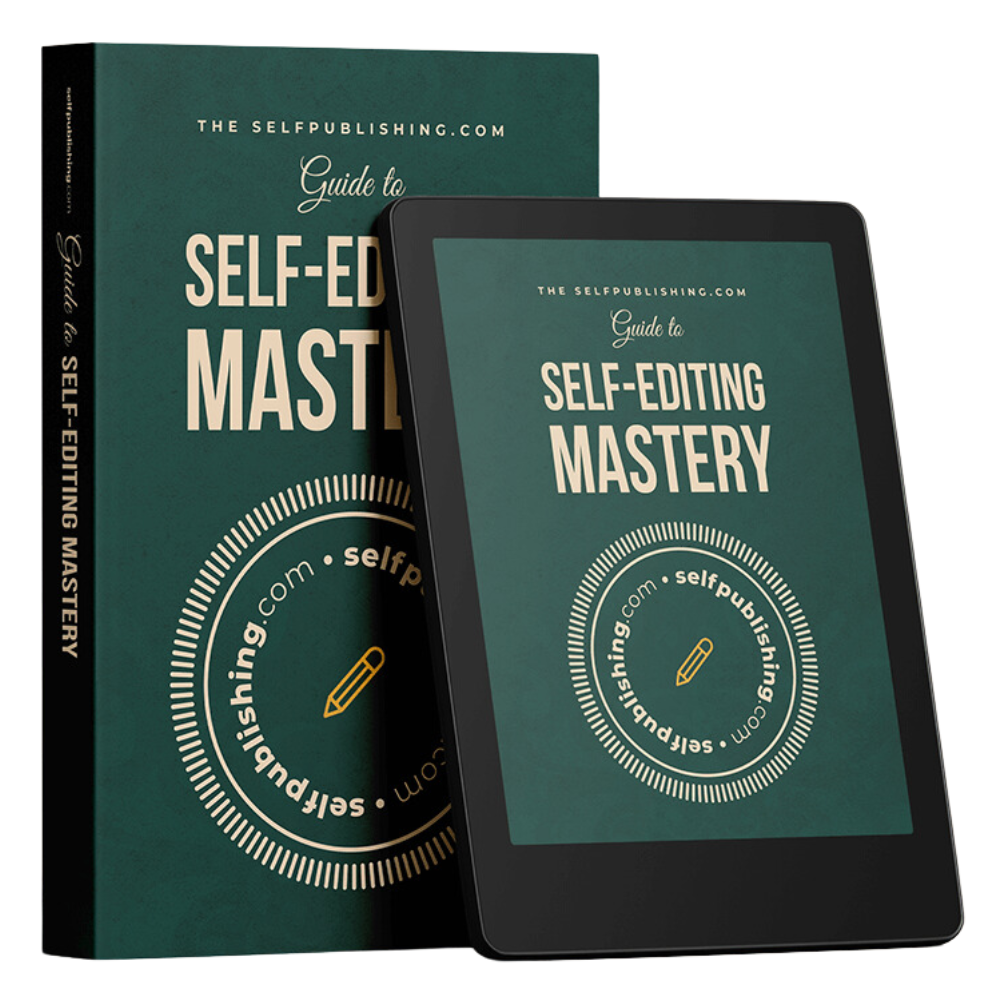Copy editing. Copyediting. Copy-editing. No matter which format you prefer to use, each one is in reference to the same type of editing.
Many writers and aspiring authors looking to self-publish their book have a variety of questions around copy editing, and we’re here to help answer them.
What is copyediting? What is the difference between copy editing vs line editing? What should you expect once you find a book editor for your project? Let’s dive into all the details of this important step in the book publishing process.
What is copyediting?
By definition, copy editing is the process of reviewing your work before publication by correcting mistakes, checking for inaccuracies, and preventing repetition in your writing.
The Webster’s Dictionary definition is:
“An editor who prepares copy for the typesetter.”
That’s a vague definition, so let’s break it down by explaining what exactly a copy editor does.
A copy edit is the lowest level of edit. Rarely does a manuscript need “just” a copy edit.
Sometimes a copy edit is a final step performed separately by your editor or someone else with fresh eyes. Some editors (like me) do copy editing along the entire process looking to fix these types of errors.
Copy editing involves the following tasks:
- Correct any typos, which would include misspelled words.
- Fill in missing words.
- Format the manuscript before production, and that includes just one space between sentences (I don’t care what you learned in typing class in high school, the double space messes up the document when it is converted into real book pages).
- Streamline punctuation and properly use commas, periods, and em dashes. Avoid overuse of ellipses to denote a break in thought…when they are really used to show missing text. And those exclamations marks! I allow authors about five in each manuscript. Overuse them, and they lose their punch. (I removed thousands of exclamation marks in one book I edited.)
- Make sure the names of characters and places are spelled consistently throughout. (Peterson in Chapter 1 may or may not be the same Petersen in Chapter 6).
- Find and replace similarly sounding words with far different meanings (affect/effect, their/there, and its/it’s are mistakenly used).
- Conduct a modest fact check (perform a Google search to find the exact spelling of Katharine Hepburn or the capital of Mongolia). This isn’t Jeopardy!, so you do get to consult resources. I keep a window open to Google just for such searches.
- Make new paragraphs to break up long passages.
- Question the use of song lyrics and remind the author to get written permission.
- Call attention to missing reference sources in the citations.
- Remove overuse of quotation marks. For emphasis, use italics, but sparingly. Books generally do not use boldface and never underline.
- Impose a consistent style for the text (this means using a style guide for capitalization and hyphenation, treatment of numbers, and heading levels). The Chicago Manual of Style is preferred unless the work needs to conform to an academic convention such as APA, AMA, or MLA.
So, what is copy editing? By now, you should hopefully have a solid understanding of all that a copy editor would do when it comes to editing your book and preparing it to be published. But it’s important to understand how copy editing differs from other styles of editing.
These are the different types of edits:
- Line editing and copy editing are often used to signify the lower levels of editing (meaning the editor tinkers with the sentences and words). I will explain the differences between these two types of editing below.
- Developmental and substantive editing describe more drastic changes and suggestions.
- Proofreading is an entirely different step in book production that corrects absolute error when the book is in final page proofs.
Is copy editing necessary?
Yes. In short, editing is important because readers expect and deserve a clean read.
When you have a thoroughly edited fiction novel or nonfiction book, readers are better able to enjoy your character development and poignant scenes instead of getting hung up on misspelled words and clunky punctuation.
The fact of the matter is that poorly edited writing almost always turns readers away, and most readers aren’t forgiving when the errors in your writing distract them from your story.
Editing helps you avoid the cruel (but often true) Amazon kiss-of-death reviews that say “needed an editor” or “should have used spellcheck.”
Reasons why copy editing is necessary:
- It improves the reader’s experience
- It makes your writing better
- It helps people take your books seriously (and want to buy them!)
Are we editors perfect? Never. But we can get close.
And that’s exactly why editing is necessary – it helps us get your writing close to perfect.
Those pesky typos can turn up where we least expect them and cause many a conscientious editor to wake up in a cold sweat over a point of grammar, only to turn to our well-worn copy of the Chicago Manual of Style, the industry bible and arbiter of all things editing.
New authors are often confused about what level of editing they need, and rightly so. With so many variations of editing, and a sea of editors specializing in one type of edit, it can be difficult to keep track.
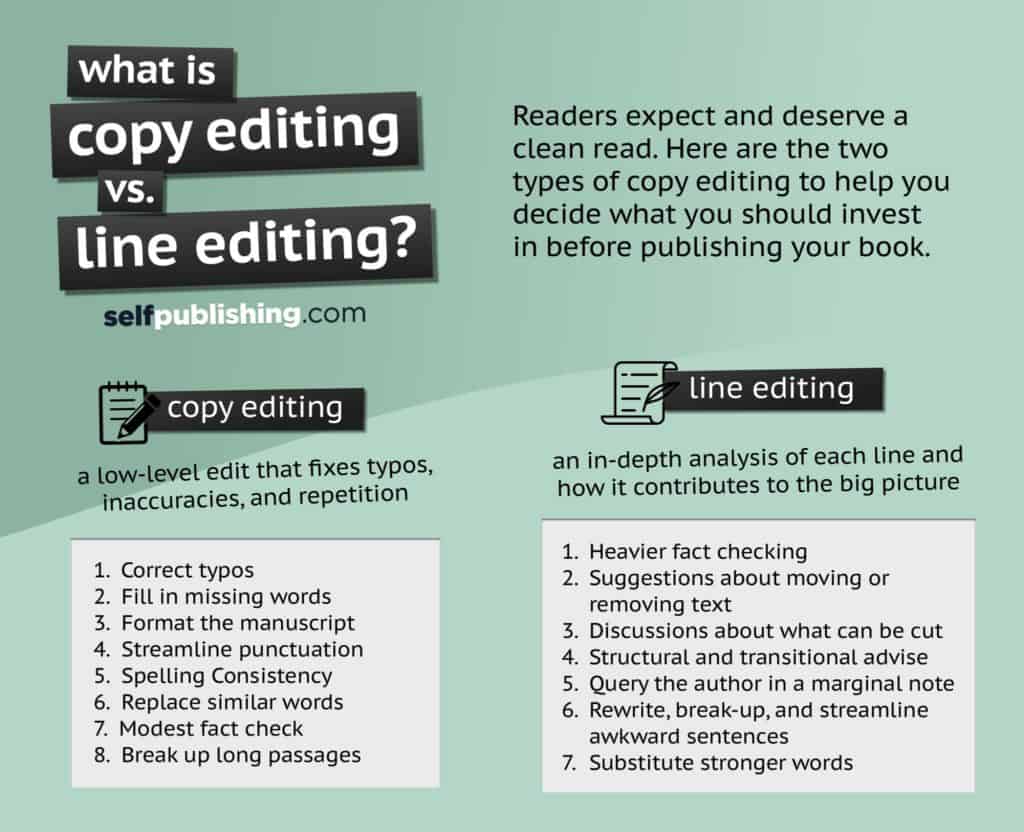
Copy editing vs line editing
When it comes to understanding copy editing vs line editing, there seems to be some gray matter and overlap.
For guidance on defining copy editing as it differentiates from line editing, I turned to the all-knowing authority, the Chicago manual. Yet even that widely accepted authority doesn’t make a distinction among editing levels:
“Manuscript editing, also called copyediting or line editing, requires attention to every word and mark of punctuation in a manuscript, a thorough knowledge of the style to be followed, and the ability to make quick, logical, and defensible decisions.”
See chapter 2 in the Chicago Manual of Style
For purposes of this blog post, let me attempt to explain the thin red line between line editing and copy editing.
Spoiler alert: not much difference.
Similar but still very different, a copy edit is a low-level edit that fixes typos, inaccuracies, and repetition, while a line edit is basically a deeper, line-by-line version of a copy edit.
Copy editing is a surface-level edit, while line editing takes it deeper. Line editing focuses on how you are communicating your ideas by analyzing the construction of your writing closely, line-by-line.
In line editing, the editor looks at how your ideas are communicated through your writing by conducting an in-depth analysis of each line and how it contributes to the big picture.
To clarify the difference between copy editing vs line editing, let’s look at some tangible examples of tasks a line edit might include.
A line edit covers all the editing tasks on my checklist for a copy edit, plus a deeper sentence-level look at additional fixes.
Line editing includes these tasks, whereas copy editing does not:
- Heavier fact checking (for example, exact titles of movies in italics, death date of a famous person in history, the protagonist using an iPhone before they were invented).
- Suggestions about moving or removing text (or actually doing the task and explaining why in a marginal note).
- Initiating discussions about what can be cut, such as the dreary Introduction.
- Offering a new scheme for moving a chapter or two around to better accommodate a timeline. (Actually doing the moving and writing transitions might fall into the category of developmental edit.)
- Querying the author in a marginal note about why Susan in Chapter 2 was wearing a winter coat when the scene takes place in summer. Or whether the author intended for the detective described earlier with a full beard to be scratching his stubble.
- Rewriting awkward sentences, breaking up long sentences, or streamlining sentences with clauses and parenthetical phrases. A line editor may recast sentences that begin with There are and It is. Those constructions are simply not strong. That’s why line editing is considered a sentence-level type of edit.
- Substituting stronger words for commonly overused words (very, pretty, things, great, really, and good are my pet peeves).
When asking a potential editor “What is a copy edit?” you might hear the term “proofread” used interchangeably as well. So, what’s the actual difference there?
Copy editing vs proofreading
A copy edit focuses on fixing a wide range of mistakes, whereas proofreading focuses on small typographical errors and formatting issues, but does not suggest major changes.
A proofreader works with a “proof” – or a nearly finished product or work. Proofreading is typically conducted after the manuscript has been entirely edited and designed, as a final check before printing.
Copy editing is often used interchangeably with proofreading, because as you can see, there are some overlaps. But, if we were to explain it in terms of depth, a copy edit is a low-level edit, and a proofread is an even lower level edit.
Despite these differences, both types of edits are important, and if you’re hiring an editor to complete an in-depth edit on your manuscript, a copy edit and proofread will likely be included.
How to copy edit writing
As editors, we’re big on pushing our authors to “show, don’t tell.” So let me do the same.
The Word feature of Track Changes (under the Review tab) is the most powerful way to mark and exchange a document between author and editor. Some editors/authors are also working with Google Docs.
The following examples show how the mark-up looks in Word and the kinds of conversations the author and editor have in the margin.
Consider this example of a simple copyedit:
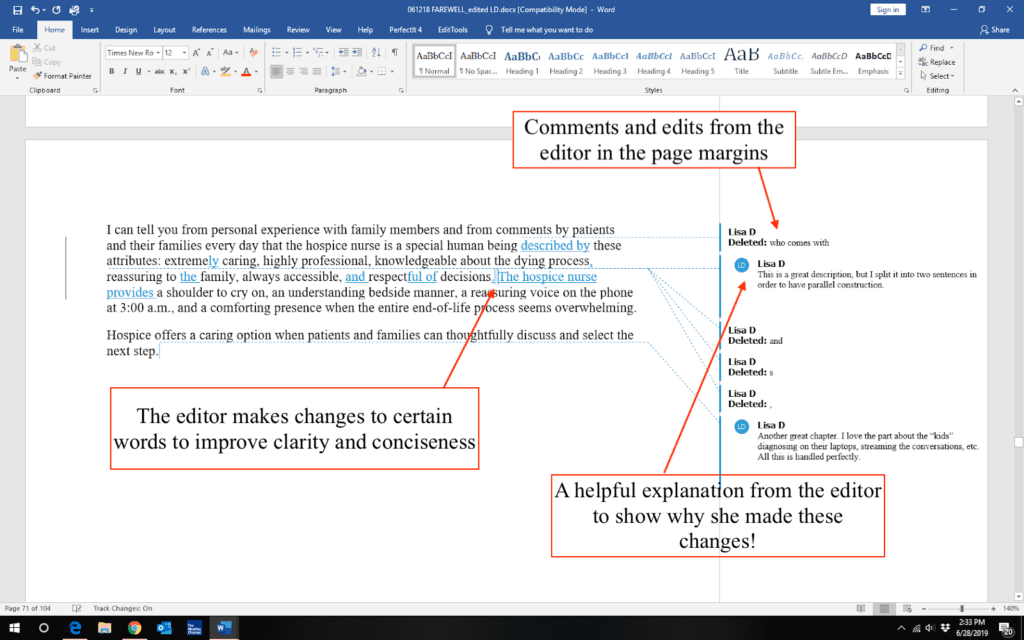
The editor has explained why she changed the wording of a sentence (to make the elements parallel). Explanation isn’t always necessary, of course, but in this case Lisa was justifying a fine point. She also offers a pat on the back with her last comment, which is always appreciated.
Eagle-eyed editors stray into the line editing side, with a deeper edit, and make observations like this:
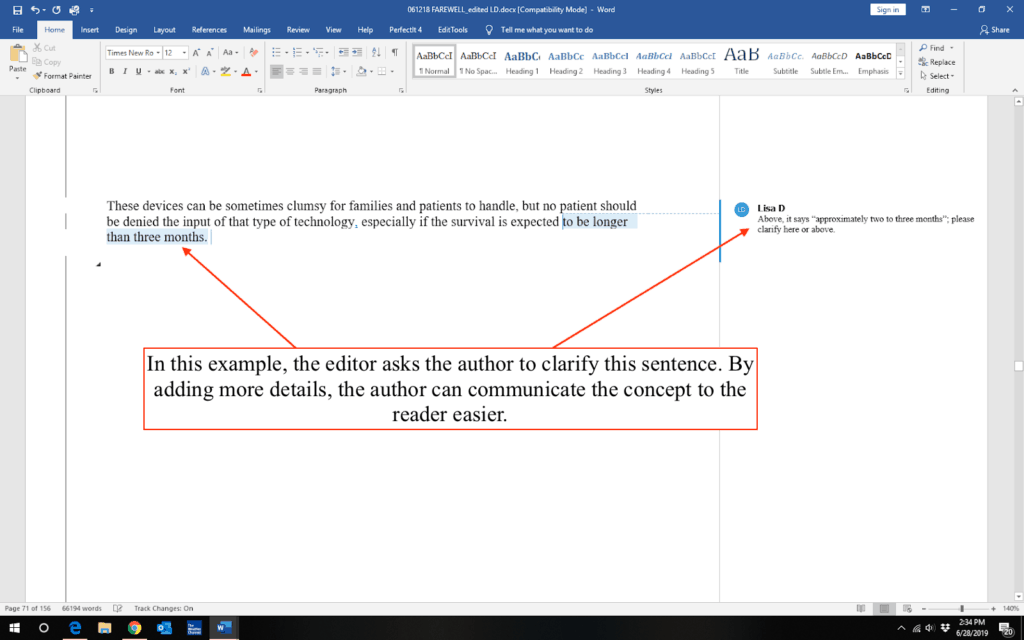
Line editors also smooth awkward sentences that aren’t necessarily wrong.
The line edit tinkers at the sentence level like this, but note that a line edit also performs the copy editing task, as noted in the last line where the editor supplied a missing word:
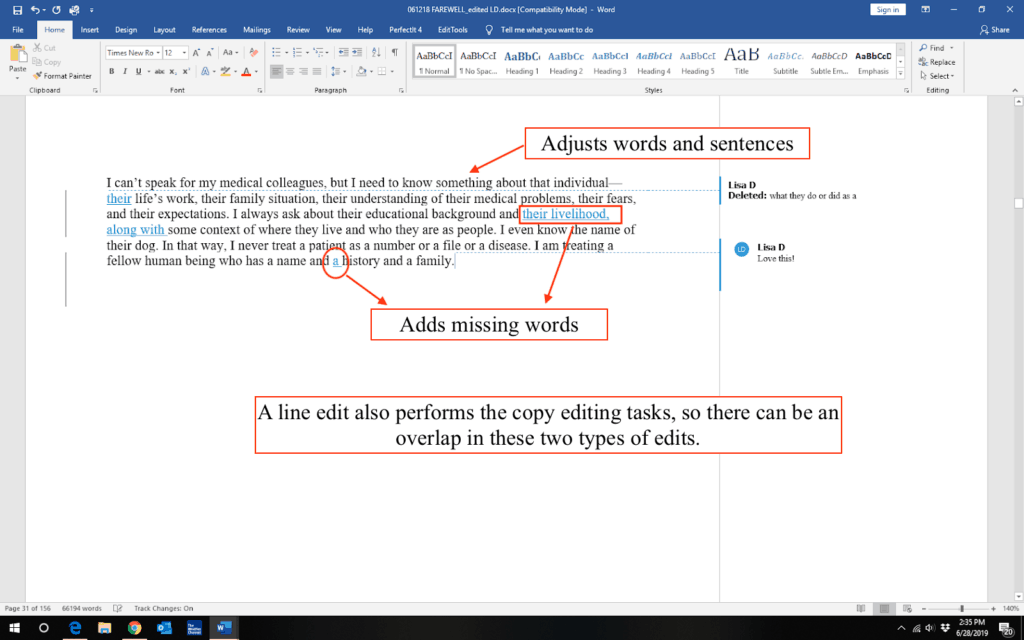
The bottom line is that line editing, in my view, is also a copy edit. Not only does a line editor adjust and reword sentences here and there, but also makes suggestions about global points.
Related: How to Become an Editor for Books
Should you copy edit your book?
While it might seem like there are many points of disagreement in the editing world, we editors do agree on one overriding principle, which is this:
Your manuscript deserves a professional and sound edit to make it free of typical errors of spelling and punctuation, with proper use of the right word, judicial paragraphing, logical chapter breaks and helpful chapter titles, prudent fact checking for accuracy—and, above all, consistency.
As Random House copy chief Benjamin Dreyer said in his exceptionally fascinating book, Dreyer’s English:
“My job is to lay my hands on that piece of writing and make it…better. Cleaner. Clearer. More efficient. Not to rewrite it…but to burnish and polish it and make it the best possible version of itself that it can be.”
Wouldn’t it be great—(oh, sorry, my pet peeve word). Wouldn’t it be helpful to have software that edits for you?
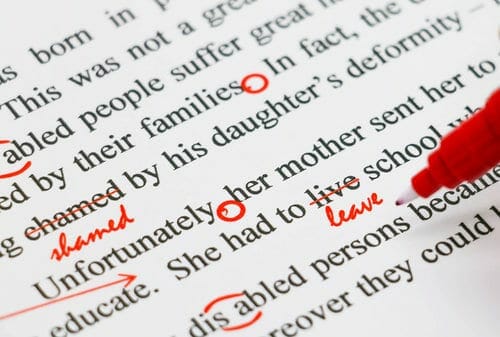
Sure, you can find book writing software that claims to help you edit, cut the extraneous words, suggest stronger words, flag inconsistency, denote caps in one place and lower case in another, and point out poor construction.
You can experiment with helpful tools like PerfectIt, Grammarly, and the built-in Spelling & Grammar checker in Word, but none are foolproof.
I suggest authors use the spelling check but disregard the grammar check. Even when Word and Google Docs underline words and phrases for you to consider, the suggestions are often wrong.
Until AI nails editing, nothing beats a real human with an eye for editing and style—and handy resources.
When I edit, I open my online unabridged Merriam-Webster dictionary (the preferred guide for books), the Chicago guide online, and Google to fact check.
I also have a cheat sheet for commonly looked-up words such as African American, cell phone, decision-maker, long-term as an adjective, side-by-side, workout as a noun but work out as a verb, and 6:00 a.m. to express time.
Can a machine do that?
How to work with a copy editor
Your editor is not (and should not be) a rigid tyrant. You are the author. Your name is on the front cover of your book.
Your editor is a professional who can guide you in writing the best book you can.
We’re also not your high school English teacher, so we will actually make editorial changes for you and leave you kind notes in the margin.
We’ll explain why you might consider different phrasing, and we’ll suggest alternative words for you.
We also don’t grade you, and your graduation doesn’t depend on your writing a sterling essay.
We know the rules of writing and can help you apply them.
But the question remains about which level of editing your manuscript needs. Use our expertise to decide and follow a few smart steps to come to an agreement with your editor before any proverbial red pencils hit the paper.
What to do when working with a copy editor:
- Submit your entire manuscript to an editor. We need to see the entire beast, not just the tail (which is usually your first chapter, often the most rewritten and thus cleaner).
- Let us evaluate the level of editing and pronounce a line edit or copy edit to move your work along toward publication.
- Ask an editor to perform a sample edit of, say, five pages or several hundred words. Then you can see the level of edit the editor is performing on your work. Let the editor choose where to draw that sample from (I randomly scroll and stop in the middle).
- Make sure the editor knows your goals for the edit. If you just want your words cleaned up, then you want a copy edit.
- If you’re not open to making changes or letting someone tinker with your words, then go with a copy edit.
- Be open to editorial suggestions but know that you have the final say.
- Know when you want to break the rules. Editors should be open to capitalizing key phrases in your industry, for example, even when Chicago style would not suggest caps.
What not to do when working with a copy editor:
Don’t expect editors to write best sellers.
If we could, I’d write one with my name on the front cover. Even though we are in the silk purse business, I’ve seen many sows’ ears that will never be silk purses.
A line edit and copy edit help you put your best work forward. I call it getting the mustard stains out of the blouse or tie, so they’re not distracting.
Don’t ask the editor, “Is this good?”
Here’s what I tell authors I work with: I can tell you if I enjoyed your story or the history or memoir or plot and characters. I am one person who may not be your target reader.
I can give you my opinion. If you want to test your work on the market of target readers, consider a beta reader process.
I can make your manuscript mechanically sound and ready for publication. The goal of a line edit or copy edit is not to create the next Pulitzer Prize–winning work.
It’s to help you be as close to error-free as possible.
Although we’ve conducted an analysis of copy editing, I hope you’re not feeling too overwhelmed.
Even if you don’t realize it now, the details will help you understand the big picture and prepare for your book’s editing process.
Now that you understand what copy editing is, as well as the difference between copy editing vs line editing vs proofreading, you’re better equipped to understand what type of edits your manuscript will need to prepare it for publishing.

